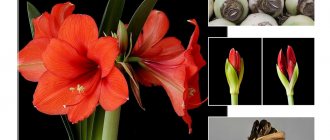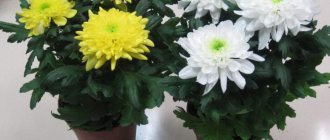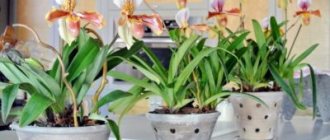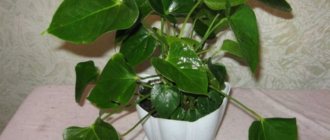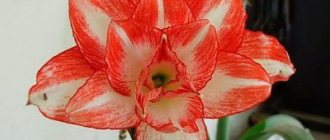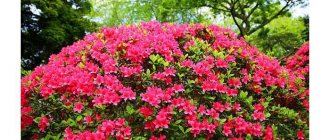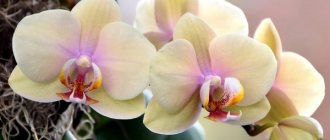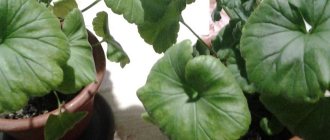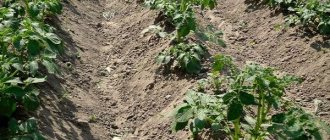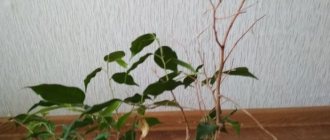Hoya propagation
Hoya propagation by cuttings
Hoya cuttings
This is the easiest way to propagate wax ivy, since its cuttings take root easily and quickly. You will need to cut a short cutting with two or four leaves and two or more nodes. They can be placed in water or directly into the substrate. The soil for propagation must be loose. Water should not stagnate in it.
Rooting in water:
- Cut off the leaves from the bottom of the cutting, leaving only the top leaves.
- Treat the lower sections with root hormone.
- Wrap a jar or other container with water in foil on the side and top, after pouring water into it with a temperature of up to +22 degrees.
- Pierce the foil with a handle and place it in water so that the bottom node is in the water.
- Place a transparent bag over the cuttings and container. Inside the bag there will be increased air humidity, which is necessary for better rooting. Otherwise, the cuttings may simply wither. However, there is no need to block the air supply.
After about two weeks, roots will appear, and the Hoya cuttings will need to be immediately planted in a small pot filled with soil. If you miss time, the cuttings will become fragile.
Rooting Hoya cuttings in soil:
- Treat the lower cut of the cutting with root and place it in moist soil so that the lower node is in the substrate.
- Place a transparent bag over the pot.
The cuttings should take root in the soil in two or three weeks. When new leaves begin to appear on them, the bag can be removed. Wax ivy grown from cuttings will bloom in the fourth year.
Hoya propagation by layering
For this method of propagation, a long shoot is selected and a pot of soil is prepared, which must be placed next to the wax ivy. The soil must contain peat and be nutritious.
The place of the shoot, which will be placed in the ground, is slightly incised. The branch is placed in a nearby pot. There should be a knot and an incision located on the shoot in the ground. The branch is attached to the soil with a pin or bent wire. Moss is placed on top and the pot is covered with film. The moss must first be watered. When roots appear on the removed branch, it gets stronger and produces new leaves, it can be separated from the mother plant.
The shoot with roots can be left in the same pot or transplanted into a new one. Hoya propagated by layering will bloom within a year.
Hoya from seeds
Hoya propagation by seeds is rarely carried out by flower growers, since planting material for vines is difficult to find on sale, and it is almost impossible to obtain seeds from home ivy. But if you are lucky and you purchased seeds or seeds formed and ripened on your beauty after flowering, then they can be used for planting. This must be done immediately, otherwise the planting material will lose its viability.
For sowing, use a mixture of soil and cut sphagnum moss. The seeds are placed in a moist substrate, and the crops are covered with film on top. The container is placed in a bright, warm place, and the soil moisture is constantly monitored. The crops are ventilated every day.
If the seeds are good, seedlings will appear in a week. They will grow slowly. Only after about three months will several pairs of leaves appear on the young plants, and they can be planted in separate small pots.
On Valentine's Day, in flower shops you can see heart-shaped leaves in small pots. These are rooted leaves of Hoya. Only some types of vines reproduce in this way (for example, Hoya Kerry). The cut leaf is simply placed in a damp substrate and covered with a transparent bag. Roots on the leaf will appear quickly, but a new shoot can wait a long time or not at all.
What to do to see the blooming flowers?
Questions are often asked about why hoya does not grow? To get a flowering plant, you need to carefully observe the conditions for its cultivation. There are rules of care and ways to make hoya bloom at home.
When choosing a plant for a room, you need to consider its size. Some plants grow quite large, like real trees. Other types are compact and do not take up much space.
You can hang the flowerpot high or wrap the stems around a support.
Flowerpot size
Depends on the age and variety of the plant:
- For decorative flowers, ordinary pots are suitable;
- for climbing plants, hanging pots are used;
- Large varieties need to be planted in large flowerpots. Lighting.
The plant comes from tropical rainforests, so it grows best in areas with bright, indirect light. The pot should be placed as close to the window as possible.
Proper watering
Khoja does not like intensive watering, prefers light drying. Watering should be done moderately. Excess water is very harmful. Fertilizers are given during the growth and flowering period once every 2 weeks, with a gradual reduction in the dose.
Note! Watering should be done moderately. Excess water is very harmful. Fertilizers are given during the growth and flowering period once every 2 weeks, with a gradual reduction in the dose.
Wintering
Hoya usually rests in winter, so you need to reduce irrigation and fertilization. Most often, the plant blooms in spring and summer and requires regular watering, spraying and fertilizing.
Substrate
Some plant species require highly acidic soil. There are varieties that cannot grow normally if the room is less than +20 degrees.
"Bathhouse"
To stimulate the release of peduncles, the heating method is often used. To do this, place the flowerpot in a bucket of warm water (+40 degrees) and leave to warm up for 1-2 hours.
Types and varieties of Hoya
In indoor floriculture, Hoya is grown in different ways:
- as an ampelous plant in a flowerpot;
- like ivy around a support;
- like a bush with an erect stem.
To do this, select the appropriate type of Hoya.
Hoya majestic
The homeland of Hoya Majestic or Imperial (Hoya imperialis) is the Malacca Peninsula. Grows as a climbing shrub. The leaves are oval-shaped, oblong, with a slightly pointed tip. They are large, up to 20 cm in length. The surface of the leaves is smooth and leathery. The flowers are collected in hanging umbrellas of 6 - 10 pieces. They are dark red inside and yellowish green outside. Their petals look like stars and smell pleasant.
Hoya Beautiful
Hoya Bella is an ampelous type of plant. Brought from India, perfectly adapted to high room temperatures and humidity. It has the appearance of a small shrub with creeping shoots, which are covered with small, thick, pointed leaves up to 2.5 cm in length. It blooms with medium-sized white flowers, the crown of which is a unique red or red-violet color. Blooms profusely throughout the summer. The aroma of this type of Hoya is less pronounced than others, so the flower can be placed almost anywhere in the apartment.
Hoya Greenflower
Hoya Chlorantha is a very showy plant with elongated leaves and velvety flowers of white, brown or greenish color.
Hoya Fleshy
Hoya Carnosa is a very popular vine among gardeners. It grows naturally in India, China, Vietnam, Malaysia, and Japan. Reaches a length of 6 meters. It is necessary to tie it up or install a ring support so that the thin stems of the plant wrap around it. This type of vine has different flowers depending on its variety. Thus, the variety Variegata has flowers of a pinkish tint with a white edge, and Tricolor has leaves that have a green edge, and the middle is first colored red, and changes to yellow as it grows. Hoya Exotica has leaves with a yellow center and green edges. The Crimson Queen variety has bright pink flowers with a pale pink edge.
Hoya Motoskei
Hoya Motoskei is a long, up to 6 meters, vine with drooping creeping stems. Its dark green leaves are oblong or heart-shaped. They are fleshy and shiny in appearance. The leaf length reaches 8 cm, and the width is up to 4 cm. The flowers of the vine are pale beige or white, with a pink crown in the center. They are collected in umbrellas and have a very pleasant aroma.
Hoya Multiflora
Hoya Multiflora was brought to us from Malaysia. It grows in the form of ivy with linear oblong leaves. It blooms early with long orange flowers with narrow yellow petals in the shape of a star with a tip-shaped center. It most often has large leaves, although there are species with small leaves.
Hoya Kerry
Hoya Kerri is another ivy-like species. This variety of Wax Ivy was discovered in 1911 by the American scientist A. Kerry in northern Thailand. This vine was named in his honor. Very beautiful view. Long stems need staking. The pubescent flowers are collected in spherical umbrellas of 15 - 25 pieces. Their color depends on the plant’s exposure to sunlight: from white with a barely noticeable lemon tint to yellow-lemon and pinkish. The older the plant, the darker its flowers become. It is distinguished by an unusual leaf shape - in the shape of a heart. This flower is called Valentine or Hoya of lovers. In order to grow this amazing plant, it is enough to plant one heart in the ground - very soon it will take root.
Hoya Concave
Hoya Lacunosa lives in Malaysia. It has small diamond-shaped leaves, light green in color with a darker edge. Flowers have a subtle, pleasant aroma, similar to perfume. This type of vine is considered the most unpretentious to care for and is very popular among novice gardeners.
Hoya Cupulata
Hoya Cupped (Hoya Calycina) is an upright plant species. Its difference is in the leaf plates - they are the longest, up to 20 cm in length.
This may be interesting: Pedilanthus - features of care at home
What to add to the water to make the Christmas tree bloom well?
In order for the Christmas tree to regularly delight with long-lasting lush flowering, it is important to provide the plant with nutrients. From May to September it is necessary to organize feeding of the Decembrist, combining fertilization with watering
Such events should be held once a month. You can use organic fertilizers or ready-made mixtures for flowers “Kemira”, “Bud” and others.
Special fertilizers for cacti are best suited. Such compositions contain little nitrogen. An excess of this substance negatively affects the roots of the Decembrist. To prepare the solution, you need to take half the portion recommended on the product packaging. In summer, the frequency of fertilizing should be increased to twice a month, and from the beginning of August - gradually reduced. There is no need to apply fertilizer in the fall.
During the flowering period, Decembrist requires a lot of nutrients. To prevent the buds from falling off, you should feed the plant. For this purpose the following are used:
- fertilizers for flowering cacti;
- phosphorus and potassium supplements.
Phosphorus fertilizers stimulate the formation of a large number of healthy buds. Potassium - strengthens the plant. A fed Decembrist will not begin to wither after the end of the flowering stage and will successfully continue its growth.
The main thing is not to use fertilizers containing nitrogen. This component causes the appearance of new shoots and leaves, suppressing the formation of buds.
Errors in caring for Schlumbergera and possible diseases
If the Decembrist does not please with the abundance of buds and blooms poorly, there are reasons that should be sorted out.
The appearance of a red tick. If orange dots are visible at the base of the flower, it means that a harmful insect is eating the flower. As a result, it becomes sluggish, segments and buds fall off. Help: first you can try wiping the Decembrist with a soap solution, if this does not give results, then treat it with an insecticide solution.
Because of illnesses. Sometimes Schlumbergera suffers from fungal infections that provoke the development of rot. Due to this, the plant cannot fully bloom and loses some of its buds and turgor. Help: First of all, you need to inspect the root system and remove rotten parts. Then treat the flower with systemic fungicides and replant. And also pick off the flowers so that the plant spends its vitality on fighting the disease, and not on flowering.
Incorrect room temperature. Zygocactus flowers fall at critical air temperatures of +10°C and below. But even in a warm room it blooms poorly. Help: during flowering the temperature should be maintained at +15°C, then the process will be long and abundant
To do this, the plant must be taken to a warm balcony, where the required parameters can be maintained, or to a separate room.
Attention! This temperature is not suitable for living rooms, since a person will feel uncomfortable living in these conditions.
Nutritional deficiency. Rare and small inflorescences signal a lack of nutrients in the soil
The plant is exhausted. It cannot throw out and feed more buds. Help: feed with preparations based on potassium or phosphorus. Adhere to the correct diet in accordance with the seasons of the year.
Although Schlumbergera belongs to the Cactus family, this does not mean at all that it loves light and tolerates drought well. On the contrary, diffused lighting and regular watering are most suitable for the flower. And the most important thing to remember is that you cannot twist and turn the Decembrist during flowering.
Hoya does not bloom, the reason is improper care
Sometimes, all the failure in a relationship with a beautiful vine is based only on the fact that it is not provided with proper care:
- Location. Although this family is not one of those that are used to frying in the sun, being under diffused and constant light is the plant’s habitat. So, first of all, the vine must receive proper registration on the southern, eastern or western window, and in the very first row, directly in front of the glass (but from the beginning of spring, during the phase of active midday sun, the crop must be shaded to avoid burns). Burns will also occur if the vine is pressed against the window panel. It is best to plant hoya in a hanging pot, and attach the stems around the perimeter of the window. Plants located far away or on a north window will not bloom.
- It is important to observe the temperature regime. In summer, the ambient temperature should be from 22 to 25 degrees; a temperature of 16 to 18 degrees will help to endure the winter months favorably. Of course, hoya will survive the winter well even in warmer winters, but this will not have a positive effect on flowering.
- Hoya loves a warm shower and plenty of watering. But the legs should be dry, and not vegetate in stagnant water. So good drainage is necessary. In principle, dry air is not an obstacle to the life of a plant, but this factor will lead to either poor flowering or its complete absence.
- Liana loves tasty additives in the form of organic and mineral fertilizers. But if it is oversaturated, it begins to get lazy, only grows leaf mass, completely forgets about its flowers, and also attracts fungal diseases.
Simple rules will help create an excellent microclimate in which the hoya will feel at home, and, relaxing under the gentle warmth of the emerging spring sun, will bloom white and pink star-shaped inflorescences.
Features of growing a flower
Cultivated hoya is divided into three varieties:
- Hoya hanging (placed in a hanging pot on the wall)
- Ivy (wraps around the support)
- Erect or bushy
- Hoya is a plant that is not afraid of shade. The place for hoya can be determined in a place that is not very sunny, then its stems grow well. But if you want the plant to bloom, you need to find a brighter place for it. In addition, Hoya needs 14 to 16 hours of daylight. Therefore, in winter, you can extend it using a fluorescent lamp.
When breeding Hoya, you only need to comply with a few conditions:
- Proper watering
- Regular feeding during flowering
- Fresh air
- Occasional bathing
- soil composition
- Permanent location of the plant during the flowering period (moving will cause it to shed buds)
general information
Hoya is an indoor flower that owners are truly proud of, because this tropical inhabitant is incredibly beautiful and fragrant, especially during the flowering period. The plant is an evergreen vine that can grow up to 5–6 meters in length. In its natural environment, it can be found in South and Southeast Asia, the western coastal zone of Australia and Polynesia.
Liana prefers to grow in open forests, choosing large, stable trees as supports. As it grows, it acquires young foliage and aerial roots. Initially, its shoots are green, but then they become lignified.
Hoya foliage is leathery, moderately fleshy, with a waxy surface and gray speckles. Young vines have shiny leaves, but over time they become dull.
In the axils of the leaves, leathery umbrella inflorescences appear, consisting of numerous star-shaped flowers. Sometimes such an umbrella can contain 4–5 dozen flowers. A blossoming bud retains its shape for 2.5-3 weeks, and after that a new flower takes its place.
Hoya: care at home (photo) - watering and fertilizing
This indoor plant should be watered as the soil dries out. Even 2-3 cm of dried soil is acceptable. In summer it is enough to water once a week, and in winter 2 times a month is enough. It’s better to spray it more often without getting it on the flowers. This plant loves high humidity. And, of course, try to use settled water at room temperature. When using cold water, the root system will not die, but you cannot count on lush and abundant flowering.
It is very useful for hoya to carry out such a procedure as bathing. To do this, twice a year before the flowering period, the flower pot is completely lowered into a bucket of water for 5-7 minutes. The water should be warm, even slightly heated. After such a bath, the plant will feel great. It will bloom profusely and withstand changing weather conditions much better. This procedure can also be used to stimulate the flowering process.
Fertilizer can be the most common. Liquid fertilizer is also suitable and must be applied during the growing season. Be sure to dilute this liquid with water according to the instructions. On average, twice.
Care and cultivation
In order for hoya to grow actively, it is necessary to create conditions close to its natural environment. This is not difficult to do, just follow certain rules of care.
Temperature
The optimal temperature for keeping hoya in summer is 20-30 degrees. In winter, it is reduced to 12-16 degrees, this is necessary for abundant flowering in the future. This time is considered a period of rest. In summer, the room with the plant must be ventilated. But you can’t create drafts, hoya can’t stand it.
Important! Falling and yellowing of leaves is a common cause of flower hypothermia.
Choosing a location and lighting
Hoya loves bright, diffused lighting. Western or eastern window sills work well. The plant is shaded from direct sunlight during the midday hours. On northern windows, Hoya does not have enough lighting and rarely blooms.
Daylight hours are 11-13 hours, and flowering requires 12-16 hours. Therefore, additional lighting in the form of fluorescent lamps is installed in the room.
In summer, the plant can be taken out to the balcony, but it should be protected from drafts.
Features of flowering
The plant blooms in spring and summer. Duration ranges from a couple of days to several weeks. It happens that it blooms twice during the spring-summer period. Hoya can bloom during the dormant period , but then next year there may be no inflorescences.
The flowers are very beautiful, white, red, green, purple, the color depends on the type of plant. Externally they look like they are covered with wax.
The inflorescence is in the shape of an umbrella, up to 50 flowers of different shapes grow on it, but all with 5 petals.
During flowering, fragrant nectar appears on the petals, which turns them pink.
What to do if hoya does not bloom?
It often happens that hoya does not bloom at home. This mainly happens due to improper care. The reasons for the lack of flowering are as follows:
- Lack of lighting.
- Late application of fertilizers.
- No rest period has been created.
- Frequent watering.
- Large pot size.
In order for the plant to bloom, certain actions are performed:
- Additional lighting is installed in the room.
- In winter they are kept at a temperature of 14-16 degrees.
- By autumn, watering is reduced and carried out only when the soil dries out.
- The hoya is transplanted into a smaller pot, since only shoots develop in a spacious container.
In the spring and summer, the plant must be fed with mineral fertilizers. Use liquid complex products for orchids and other succulent flowers. Feed 2 times a month. Dilute the fertilizer 2 times less than indicated in the instructions. In winter, all feeding is stopped.
During the formation of buds, the flowerpot should never be rearranged, otherwise the plant gets stressed and stops blooming.
Watering
From March to October, the hoya is watered abundantly as the top layer dries. During the rest period, reduce to 1 time per week. At the same time, they do not allow both the soil to dry out and excessive moisture.
Important! If water accumulates on the tray, it must be drained. Otherwise, the roots may rot.
Water is used that has been settled, melted or filtered.
Humidity
The leaves are periodically wiped with a damp soft cloth.
In the fall after flowering, and in the spring before flowering, hoyas are given a warm shower. The pot with the plant is lowered into a container of water heated to 30-40 degrees.
After 10-15 minutes, the stems are pulled out, and the earthen ball is left for another 30 minutes.
Autumn bathing hardens and gives strength to survive the dormant period, and a summer shower promotes rapid growth and the approach of flowering.
Reproduction
Hoya, like many other plants, is propagated at home. The seed method is not considered the most popular method, since it is difficult to find seed material. If it is still found, then it is sown in a mixture of sphagnum and soil. Water it periodically and place it in a bright place. After about a week, the first shoots appear. They are planted after about 3 months, when the first leaves appear. Other methods of reproduction are more popular and often used.
Cuttings
They take cuttings from last year's shoots, with 2-3 internodes and a couple of leaves. For good rooting, treat with root. Then they are planted in substrate or water. Keep at a temperature of 22 degrees. Cover the top with a film to create a greenhouse effect. Ventilate periodically. After two weeks, roots emerge from the nodes. After which the sprouts are transplanted into permanent soil.
By layering
The procedure is performed in early spring. A small part of the shoot is placed in a separate pot with nutritious soil, which includes peat.
Make a small incision where the shoot touches the ground. The branch is pinned using a paper clip or stone.
Cover it with moss and water it. Cover the top with polyethylene.
As soon as the young hoya gets stronger, the mother shoot is cut and the sprout is transplanted into a separate pot. Afterwards they are cared for as if they were an adult plant.
Transplant and pot
The procedure is carried out in April. Young plants are replanted every year. Adult specimens once every 3-4 years. The new pot is selected 2-3 cm larger than the old one. In a spacious container, hoya roots develop faster and shoots grow; in a cramped pot it blooms more profusely.
Important! A ceramic pot is best; its walls allow air to pass well to the roots. It must be disinfected before planting.
The transplantation process consists of the following steps:
- A drainage layer is placed at the bottom of the pot.
- Carefully pull out the plant with a lump of earth, inspect the roots and remove rotten areas.
- Place the hoya in the middle of the pot, pour soil into the empty spaces and compact it.
- Water generously and put in place.
When buying a plant in a flowering state in a store, they do not immediately transplant it into a new pot, but wait until it has finished blooming.
Priming
The plant needs loose, nutritious and breathable soil so that the roots can breathe. A ready-made mixture for violets is well suited for planting. You can prepare the substrate yourself; for this purpose, mix turf, leaf soil, sand, peat and humus in the same ratio. For drainage, use river pebbles, expanded clay or small pieces of brick.
Trimming
Hoya does not need frequent pruning. In young specimens, to form new shoots, after the appearance of the fourth leaf, pinch the branch.
To create a shape, shoots that are too elongated are also trimmed. The procedure is carried out with a sharp knife. And to stimulate abundant flowering and the formation of new branches, the stem is cut in the interval between the nodes. But under no circumstances should the flower stalks be cut off after they dry out, as new flowers will appear on them.
Related article: Crocus or saffron flowers: varieties and varieties of crocuses
Care during flowering
How to care for indoor hoya during the flowering period, because it is during this period that it requires increased attention:
It should be remembered that hoya is a guest from the tropics and does not tolerate high temperatures, so the amount of watering and irrigating the leaves in hot weather needs to be increased; you need to water carefully so that water does not get on the buds; You should not touch the inflorescences, they are very delicate and can fly off; During flowering, the plant expends a lot of energy, so complex fertilizer should be applied to the root system.
Hoya is gaining color
When does hoya bloom at home?
Hoya, which blooms in the spring and continues for a long time, is beautiful. The flowers are extraordinary, reminiscent of five-pointed stars (in Hoya Tricolor they are white). They can be confused with handmade crafts. They are collected in inflorescences of 20-30 flowers in one ball, the color of which depends on the species. A drop of nectar glistens between the petals, and the sweet smell of hoya envelops the entire room. The distinctive features of the leaves and inflorescences of different types of wax ivy are presented in the table.
| View | Leaf feature | Inflorescence color |
| Hoya fleshy | sophisticated, white canvas along the edge | small white flowers with a pinkish tint |
| Hoya regal | shiny, oval | large dark red inflorescences |
| Hoya decorated | elongated | flowers of unusual color - apricot, orange |
| Hoya Vaiety | sharp, reddish in color | light burgundy |
| Hoya Kerry | have a heart shape | cream |
| Hoya southern | glossy | white petals with a crimson center |
| Hoya Tricolor | leaves of different colors | white stars |
Why eucharis does not bloom at home and how to make it bloom
Why Eucharis Doesn't Bloom Home Care Rules
Provide the plant with proper care, and it will delight you with beautiful, fragrant flowers two or three times a year. The lily's flowers open one at a time and bloom for up to ten days each. Gardeners can create an artificial watering and fertilizing schedule for the lily, which will ensure that the plant blooms multiple times throughout the year.
Proven watering and fertilizing schedule:
- January + 1st half of February = rest period
- 2nd half of February + 1st half of March = active growing season
- 2nd half of March + 1st half of April = flowering phase
- 2nd half of April = active growing season
- May + 1st half of June = rest period
- 2nd half of June + 1st half of July = active growing season
- 2nd half of July + 1st half of August = flowering phase
- 2nd half of August = active growing season
- September + 1st half of October = rest period
- 2nd half of October + 1st half of November = active growing season
- 2nd half of November + 1st half of December = flowering phase
- 2nd half of December = active growing season
Why doesn't Eucharis bloom? Errors in care video
Sometimes the plant does not bloom even though it seems to be in optimal conditions.
This means the gardener made a mistake. Here are the most common:
- Incorrect landing. The young plant is planted in a wide container, the diameter of which is many times greater than the diameter of the bulb. The tighter the plant is in the pot, the faster it will bloom.
- Sudden change in room temperature. The plant will form weak flower arrows or its bulb will rot, and flowering will not occur if the eucharis is constantly in a draft and in a state of stress.
- The resting phase has not been maintained. It should last about a month and a half. During this period, the plant is not fed and watered rarely. The lump of earth should be half dry. This is checked using moisture indicators, wooden sticks or the weight of the pot. During the dormant period, the plant needs to have good lighting.
When does it start to bloom?
Hoykas usually bloom in May-June, the flowering period of the inflorescence is approximately five days, but, to our satisfaction, simultaneous flowering does not occur; flowering is delayed, and its period depends on the size of the plant and the number of peduncles.
There is no need to pick off faded inflorescences; flowers will form on them again, and darkened flowers can be carefully removed.
It is necessary to water the plant in buds or flowers carefully, and do not shower at all; flowers and buds easily fall off if handled carelessly. They can also fall off when the direction of lighting changes, so do not move or twist the pot
Watering can be replaced by spraying; the soil must be loosened if necessary.
If in your opinion the plant is rather weak, feed it with complex fertilizer for houseplants, but not more than 2 times a month.
In the second half of summer, re-blooming is possible.
It must be remembered that hoya is an inhabitant of humid subtropical forests, and the higher the air temperature, the more moisture the plant needs.
Watering and spraying must be increased as the temperature rises; hoya will not tolerate dry, hot weather.
In the second half of September, you need to start preparing the plant for winter rest, reduce watering, do not apply fertilizers, and then move the hoyas to a wintering room, these can be insulated balconies and loggias, rooms on the north side of the house, stop watering, regularly inspect the plants, do not whether pests have appeared and patiently wait for a new spring flowering. You can learn more about why hoya does not grow, its leaves turn yellow and fall off, as well as what diseases and pests can destroy plants.
Wax ivy or hoya has more and more fans, the variety of species encourages collecting, flower growers are responsive and generous people, they are happy to exchange, sell inexpensively, or even simply give cuttings, leaves and young plants if there are too many of them (how to propagate hoyu?). How nice it is to know that an amazing plant, thanks to you, brings joy to someone else’s soul.
Wax ivy diseases
Unfortunately, the lack of flowering is not always associated with errors in the care or maintenance of the exotic vine. Often, hoya does not grow and, accordingly, does not bloom due to some disease. In this case, the entire phytoimmunity of the flower is aimed at preserving its life, without being “sprayed” on less important moments, for example, flowering.
In most cases, you can help your green pet, the main thing is to notice the symptoms in a timely manner and carry out appropriate treatment:
Stem rot
Hoya can suffer from stem rot, during which its shoots lose turgor, soften, change color, and rot. The pathogenic fungus that causes rot spreads very quickly and a severely affected flower cannot be saved, so you should act immediately.
All affected parts of the plant are removed, and the sections are sprinkled with charcoal or activated carbon powder. The soil should be carefully dug up and a small amount of coal added. Prevention of rot involves placing high-quality drainage at the bottom of the pot, which will prevent the earthen ball from becoming waterlogged.
Chlorosis
This disease occurs as a result of a failure in photosynthesis processes. Hoya leaves become light, acquire a yellowish tint and faded, whitish spots. Just looking at the vine it becomes clear that it is not healthy, has weakened and needs feeding. In this case, it is recommended to spray the flower with Ferovit, Micro Fe or another similar preparation.
Sooty fungus
A dangerous disease that leads to blockage of the vine’s respiratory system. It is not difficult to detect the fungus - it spreads like a sooty film over the foliage of the hoya.
At the first sign of illness, you should treat the foliage with a sponge soaked in a solution of laundry soap. And then disinfection is carried out with fungicidal preparations.
Alternaria blight
The disease, also called dry spotting, negatively affects the condition of the hoya foliage, which also leads to disruption of the flowering of the tropical vine. The fungus eats the lower foliage, spreading upward if it is not identified immediately. The pathogen actively reproduces with regular temperature changes and changes in humidity.
Treatment of the disease consists of removing and then destroying dead parts of the flower and treating it with copper-containing products.
Phyllostictyosis
It also affects the foliage of the vine, on which dark specks appear. They increase in size, dry out the plate, and its center crumbles as it becomes thinner than parchment.
To save the hoya, you need to replace the soil with a new one, after holding it in the oven at a temperature of +180 - +220 degrees. Diseased leaves are removed, the air humidity in the room is reduced and antifungal drugs are used.
Hoya pruning
When growing hoya, you should remember one very important rule: under no circumstances should you “touch” the flower stalks of the plant, the stems on which the inflorescence rises. They cannot be pruned or broken off even after flowering has ended.
When flowering begins to fade, flower shoots should be left on the plant: perhaps the plant will produce flowers again in comfortable conditions. But the main reason is that it is on the old peduncles that the hoya will produce inflorescences next year. And if you cut them, you will have to wait a long time for new flowering.
But the remaining shoots can be left unpruned, curling around the supports, or only the longest branches can be shortened after flowering. They are cut down to short branches, on which flower buds also form the following year. You can also shape the plant according to your needs: as soon as the branches become too elongated and become unattractive, they can be pinched or lightly trimmed, and, if desired, shortened to half the length (inflorescences also form on such shortened branches next year).
The heavy umbrellas of hoya inflorescences droop, and if you want to appreciate all their beauty and at the same time grow the vine in classic pots, then it is better to place small supports along the inflorescences.
How does it reproduce
The indoor Hoya flower propagates, like all plants, by seeds, layering, cuttings, and leaves.
Seeds
Seeds appear after flowering if you resort to artificial pollination, but this is difficult, so this type of propagation is not popular among gardeners. The method is practiced in greenhouses.
Seeds are sown only fresh, as after 6 months they lose their viability. A 1:1 mixture of sphagnum moss and universal soil is used for sowing. The container with the mixture is placed in a greenhouse where a humid regime is maintained. After a week, the seeds germinate. Over the course of three months, the sprout grows foliage. Every day the sprout is ventilated, starting from 5 minutes, gradually increasing the time to 12 hours.
By layering
The easiest way is rooting by layering. Moist soil is collected in a bowl and placed next to the flower pot. You need to put the bottom branch in it and sprinkle it with soil. A month later, roots appear under the node, this is a sign that you can cut the branch from the mother bush. After a year, the young shoot is transferred to a larger container.
Cuttings
This method of rooting takes longer. Soil for cacti is poured into a transparent small glass with drainage and moistened. The cutting is cut 1 cm below the node, dipped in a root former, and planted to the internode. It takes root under a transparent plastic cup for 45 days, ventilated and moistened every day. When the cup is filled with roots, the ivy is transplanted into a larger pot.
Reproduction is a complex process that depends on the chosen method
Leaf
Not all species reproduce by leaf method. The stem of the leaf is placed in the soil to the base and a greenhouse is made.
Important! This method is the longest, the leaf grows roots for almost a year
Transplantation at home
This flower does not like frequent transplants, since during them it can become infected with various pests, for example, spider mites. The optimal frequency of such a procedure is no more than once every 3 years.
Transplantation is carried out using the transshipment method. The roots are not cleared from the soil; the plant is placed in a larger pot along with a lump of earth, without exposing the roots.
If for some reason it is necessary to remove old soil, then do it extremely carefully.
Important! When replanting, be sure to remove dried or rotten roots. The flower is placed in a new pot and the required amount of soil is added
The flower is placed in a new pot and the required amount of soil is added.
How to plant hoya
There are several rules for planting hoya so that it takes root:
- choosing a pot. Wax ivy does not have any requirements for the material of the flowerpot. It can be ceramic or plastic. For hanging types, hanging pots are chosen. When choosing a pot for hoya, there is one secret: to form a dense crown, choose a larger pot, and for abundant flowering, choose a very small one. A very large pot has a bad effect on the development of the vine. Moisture evaporates from a plastic container more slowly than from a ceramic container; this must be remembered when watering;
- timing for planting. Like many indoor plants, Hoya needs to be replanted in the spring. Replanting in the fall can be detrimental to the flower. Most likely, it will not take root;
- suitable soil. The soil should not be overly dense. From ready-made substrates, a soil mixture for hanging plants is suitable. Hoyas also grow well in soil for Saintpaulias, begonias, and dracaenas. Experienced gardeners recommend diluting the store-bought mixture by ¼ with perlite. If you do not want to plant a flower in ready-made soil, then you can make it yourself from turf, leaf soil, peat and sand (1: 2: 1: 1);
- Drainage made of expanded clay or perlite is laid on the bottom of the pots. Then add a little soil. The hoya is placed in the center of the pot and soil is carefully poured around it. The flower must be held. If the vine requires support, it should be installed before placing the plant in the pot, otherwise the root system may be damaged when inserted.
Caring for Hoya at home is easy. The tropical beauty prefers well-lit places at home, but exposure to direct sunlight can cause burns. In the warm season it is necessary to spray frequently. The frequency of watering depends on the variety. Fertilizer is chosen for flowering succulents.
When and how to replant eucharis
Amazonian lily does not like transplants. Therefore, if the plant is healthy, blooms well and does not fall out of the flower pot, it can not be disturbed for three to four years.
Related article: Strawberries: post-harvest care, photos, watering, weeding, fertilizing and pruning
A healthy flower is transplanted when many “children” have been formed and they interfere with the normal growth of the flower.
The daughter material can be used to propagate the plant, or it may not be separated from the mother flower. In the latter case—transplanting into renewed soil without separation—you can achieve more luxuriant flowering of the lily.
March is the most favorable month for replanting a plant. A healthy plant is transplanted into prepared soil using the transshipment method, without disturbing the earthen coma.
If the flower bulbs are rotten, they are carefully removed from the soil and washed with water. Then the rot is removed (cut). The cut surface is thoroughly disinfected by immersing it in a fungicide solution. Then sprinkle the cut with wood ash.
Depending on the initial planting material (bulb with and without leaves), there are two options for planting the plant.
Planting Amazon lily with leaves
How to plant eucharis photo
Leaves are not trimmed before planting, only those that are yellowed and dying are removed.
- Planting depth - 5-6 cm.
- The container for planting is tall, not wide, with a hole in the bottom and drainage at the bottom made of expanded clay or small pebbles.
- Watering is moderate for the first 3 weeks, as the soil dries.
- The location is bright and warm.
Planting an Amazon lily without leaves
Before planting, the leaves are completely cut off at a height of 1 cm above the bulb.
- Planting depth - the top of the bulb looks 0.5 cm above the soil surface.
- The container for planting is 2-3 cm larger in diameter than the diameter of the bulb.
- The soil is half sand.
- Watering is moderate for the first three weeks, as the soil dries.
- The location is bright and warm.
If you planted an Amazon lily bulb without leaves, the plant will grow new leaves approximately 40 days after planting. The fact that the top of the bulb is above the surface of the ground will make it easy to observe the growth and development of the plant.
Reasons for lack of flowering and how to eliminate them
Disease
- To rule out disease, the plant must first be carefully examined. Causes of concern will be:
- Watery spots on leaves. They usually indicate an orchid disease with brown bacterial rot.
- Softened roots. Most often this is a sign of root rot.
- A dark coating covered with fluff directly indicates gray rot.
- Black-bluish “foci” on the leaves most likely indicate the presence of black rot.
- Yellow, losing elasticity, leaves. There may be several options here, one of them is fusarium rot.
- Spots on the ground part of the orchid. This symptom in an orchid can also indicate several different diseases, fungal or bacterial in nature.
- White coating on the leaves. The most likely diagnosis in the case of a white coating on phalaenopsis leaves is powdery mildew.
- As soon as one of the listed symptoms is detected, the first thing to do is to isolate the plant from other flowers and try to mechanically remove the affected areas. This will not solve the problem completely, but will significantly reduce the source of the disease.
- Next you need to determine the most likely type of disease. Based on the symptoms, it is quite easy to make a “diagnosis” of an orchid.
- And finally, the final step towards eliminating the disease will be the purchase and use of the drug that will relieve phalaenopsis of the disease that has arisen.
Pests
Pests can also cause a lack of flowering. By parasitizing the plant, they weaken both the root system and the ground part of the flower. In this state, the orchid does not physically have enough strength to shoot an arrow.
The most common parasites on phalaenopsis are:
- mealybug;
- spider mite;
- thrips.
To get rid of pests in a flower pot, you need to act comprehensively - first, manually collect those insects that are visible to the naked eye, then, using chemicals, get rid of undetected pests and their larvae.
The procedure for flooding the soil will help you collect the maximum number of parasites:
- The flower pot is placed in a container, like an ordinary basin.
- Water at room temperature is poured into this container so that its level is about a centimeter below the edge of the pot.
- Then you just need to wait 5-10 minutes.
After this time, all the pests that are present in the soil will begin to crawl out to the surface of the substrate. They need to be collected and removed.
To eliminate the larvae and remaining pests, you can use the “Fitoverm” insecticide, popular among flower growers. It is used to treat the soil in the pot and the above-ground part of the plant.
Improper care conditions
It is improper care that is the most common reason for the lack of flowering of phalaenopsis.
The main mistakes made by inexperienced gardeners are:
- incorrect location of the plant;
- insufficient lighting;
- disturbed temperature conditions;
- improper watering;
- excessive fertilization of the flower.
It is not difficult to correct all these errors, the main thing is to follow the following rules:
- Flower location. Do not place the orchid where it will receive direct sunlight. This will slow down the development of the plant and flowering will have to wait a very long time.
- Lighting. In summer there will be enough natural light. But in winter, phalaenopsis needs to be additionally illuminated. Regular fluorescent lamps are suitable for this.
- Temperature. Orchid is a heat-loving flower. Therefore, the temperature in the room where it grows must be at least 25°C.
- Watering. Do not moisturize phalaenopsis too often. Each subsequent watering should be carried out only when the soil from the previous watering has already dried out.
- Fertilizer. It is worth purchasing first of all those fertilizers that contain phosphorus and potassium. This will have a beneficial effect on the formation of flower buds. Such useful substances are added to the soil no more than once every 5-6 weeks.
Diseases and other growing pains
Excessive dampness and low indoor temperatures can cause fungal diseases of Hoya such as gray rot and powdery mildew. They can be easily identified by the gray or whitish spots that appear on the leaves. Powdery mildew can be treated quite successfully with chemicals and fungicides, but gray mold can destroy a plant in a matter of days.
Spots on Hoya leaves
If spots and thickening appear on the leaves, the Hoya may have a viral infection. Urgently isolate the flower from others and observe. If there is no improvement, the plant will have to be destroyed, since they have not yet learned how to fight viral diseases of flowers.
If the trunk and some shoots of the plant become soft, a sticky liquid with an unpleasant odor is released from them, the plant may have contracted a bacterial infection. It is necessary to spray the plant with copper containing preparations. Remove the affected parts of the plant.
Wax ivy can also develop non-infectious diseases, which usually arise from poor maintenance of the flower indoors.
We will tell you about the problems that most often arise when the rules for growing Hoya at home are not followed.
- Spots on the leaves appear either from excess sunlight, or from the use of cold water for irrigation, or from overfeeding the flower with mineral fertilizers.
- The leaves turn pale, curl and gradually dry out either from excess sunlight or from too low air and water temperatures for irrigation.
- Growth inhibition and pale color of greenery in Hoya can occur due to a lack of nitrogen fertilizers in the soil. It is enough to feed the plant with urea (1 g per 1 liter of water).
- Leaves can fall either from excess water in the soil or from its lack, or from high temperature and dry air in the room with a lack of watering.
- Reddening of the leaf blades is observed due to too hot air in the room or too much sunlight.
- Hoya sheds buds and flowers either due to moving the pot with a flowering plant to another place, or in case of constant overflow, or insufficient lighting.
- Excess moisture combined with poor drainage in the pot can cause root rot. Then the plant may die.
- Poor flowering of a flower is most often due to insufficient lighting. Hoya does not bloom without sunlight. And also, do not forget that some types of young plants bloom only in the second or fourth year after planting. Sometimes Hoya does not bloom at home due to the fact that it did not have a good rest during the winter. Some types of ivy simply need a break during the winter. Keeping it at a lower temperature, minimal watering, stopping feeding for two to three months, and returning after winter to a warm, bright place can force Hoya to bud and bloom profusely.
- Young shoots develop poorly, the lower leaves of Hoya turn yellow and fall off due to hypothermia of the plant at low air and soil temperatures.
Hoya: care at home - types, planting (photo)
Hoya is an easy to grow plant that is suitable even for novice amateur gardeners.
It belongs to the type of evergreen shrubs and vines. The name was given in honor of the gardener Thomas Hoy, who devoted his entire life to growing tropical plants. It can reach 10 meters in length. The stem is green with leaves and flowers of white or pink, collected in umbels located on the stem branches. Hoya blooms all summer and even mid-autumn. Peak flowering occurs in the first months of these seasons.
Depending on how hoya grows, it is divided into types:
Types of Hoya
• ampelous. Hoya beautiful is a branching shrub whose leaves resemble small white stars, Hoya lineara - leaves look like bean pods
• ivy-shaped. Hoya fleshy climbs with thin stems. Hoya multiflora, Hoya regal or majestic, Hoya Kerry, whose leaves resemble hearts and are especially popular as a gift for Valentine's Day.
Hoya Kerry
Hoya Lacunosa, which has light-colored leaves with a dark green edging, is considered the most unpretentious. The flowers have a light and pleasant aroma. These plants are lianas.
• erect. Hoya concave, pitted, Hoya Emglore.
The soil for hoya should be airtight. If you are a supporter of preparing the soil yourself, then you will need to use 3 parts of leaf soil, 2 parts of turf soil and humus, and 1 part of sand. If this is not possible, then add sand to the soil.
Hoya propagates very easily - vegetatively. To do this, separate the apical cutting from the mother plant around the end of winter. There should be at least several buds on it. After the root dries slightly, plant in the prepared soil. Pre-treat the shoot with root so that it is better accepted. The top of the pot can be covered with polyethylene. You don’t have to create greenhouse conditions, but try to ensure warm temperatures, sufficient lighting and regular watering in the first weeks. Other methods of propagation are by leaves with an axillary bud or by air layering, which must be rooted together with the mother plant and then replanted.
Hoya planting
The greatest number of problems with this plant for gardeners arise during transplantation, to which hoya is very sensitive. It is recommended to carry it out once every two to three years.
This must be done with extreme caution, since with the slightest damage to the root system, the flower may not recover and die. Try to replant with the near-root layer of soil
The features of this plant include:
• blooms better in cramped pots;
• do not remove stems that have already faded; new flowers will appear in their place. Trim only damaged leaves or only those shoots where there were no flowers;
• It is better not to move the plant when the buds appear. They might just fall off.
Reproduction of Eucharis by children
Reproduction of Eucharis by children photo
When growing a plant indoors, the easiest way is to use the vegetative method. Moreover, the Amazon lily has a large number of “children”. In March or April, they can be planted in separate containers with previously prepared soil.
An important point: only well-formed “babies” can be separated from the mother plant. Otherwise, the bulbous seed material will die.
